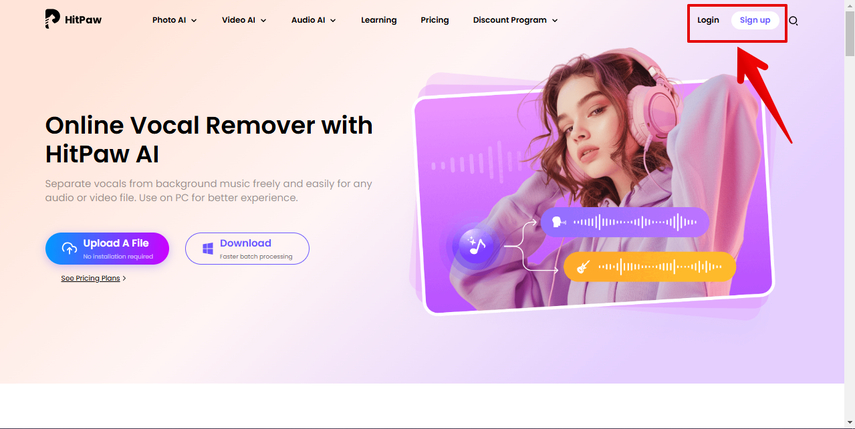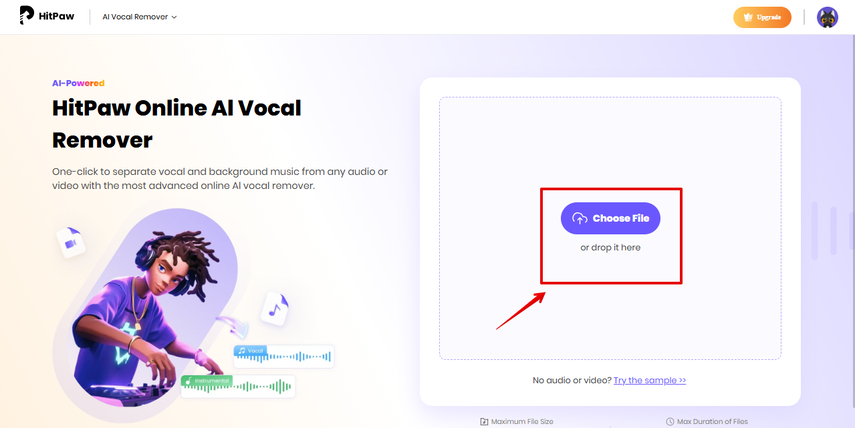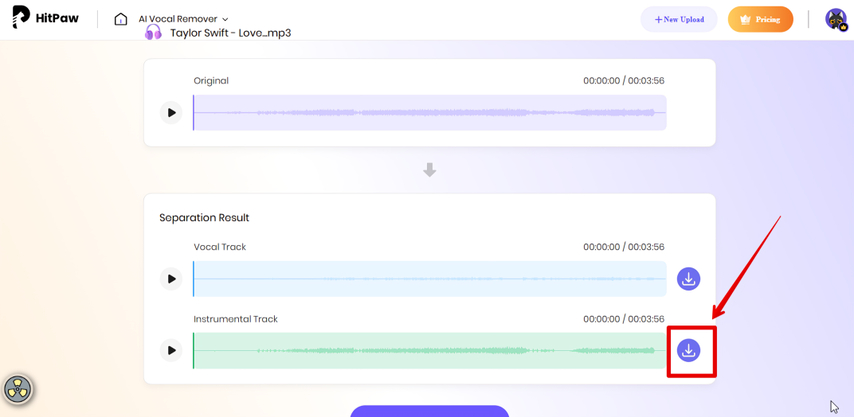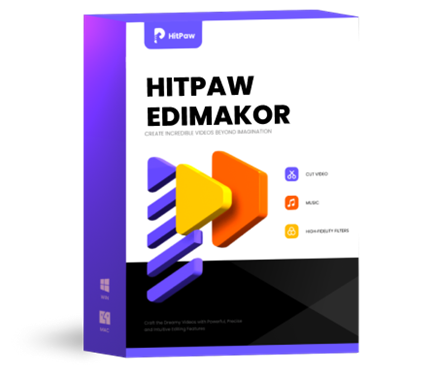From Karaoke to Custom: The Ultimate Guide to Songs Tracks for Singing!
No matter if you’re preparing for a performance, recording a song, or just practicing your vocal skills, the right songs tracks for singing can make a world of difference. These tracks give you the support you need to perfect the quality of your performance and help you express yourself with confidence.
While you can use tracks from full-band arrangements to more subtle piano accompaniment to suit your style, you may wonder where you can get them.
Well, in this article, we’ll explore some resources to find different types of royalty-free accompaniment tracks for your next singing project. We’ll also show you how you can get a custom instrumental for any audio or video file.
Try Now!Part 1. What are the Different Types of Accompaniment Tracks for Singers?
Accompaniment tracks provide backing beats for singers during live performances, practice, auditions, and karaoke sessions. They are pre-recorded or live-played instrumental pieces that help singers stay in tune, set the right tempo, and build the overall feel of the song.
These soundtracks also let singers focus on their voices without needing a live band or full arrangement.
The three main types of accompaniment tracks include:
- Written Accompaniment: These are sheet music or chord charts, which musicians can play live, often on a piano or guitar. Written accompaniment allows singers to interpret the song’s rhythm and style and perform accordingly.
- Live Accompaniment: Musicians perform the instrumental parts in real-time, either as a soloist or full band. This accompaniment setup is common in live performances where interaction between the singer and musicians adds energy to the show. However, both of them may find it hard to coordinate with each other.
- Recorded Accompaniment: Pre-recorded accompaniment tracks are full-band instrumentals, single-instrument tracks (like piano or guitar only), or genre-specific backings. They are often used for karaoke, auditions, and practice and have different styles (jazz, pop, or classical) and moods to relate to the song lyrics. The downside of recorded accompaniment is that it lacks the spontaneity of live music.
Part 2. Where Do Singers Get Backing Tracks?
You might have seen many performances with backing tracks. There are platforms that offer music tracks for singers, and you can find your favorite one on any of them to make a difference in your practice session or performance:
- YouTube Audio Library is a dedicated channel where you can find any soundtrack based on genres like jazz, hip-hop, classic, or romantic. You can also search the track by the song title or instrumental arrangement.
- SoundCloud is specifically developed for independent artists and has over 320 million original music and remixes that you can use for your singing sessions.
- Karaoke Version, a virtual center, lets you modify the key, configure the instrumental tracks, and remove lead or backing vocals to create your own remix of iconic songs. You can then download the custom track in MP3 format to your device.
- Sing2Piano is another great resource for anyone looking for acoustic performance tracks, especially in the pop music genre.
When choosing a track, it’s important that you consider the range of your vocals, tempo, and style. This is because a well-matched instrumental complements your natural voice and the intended feel of the song you want to perform. For instance, a slower tempo can work well for ballads, while upbeat ones are better for lively songs.
Part 3. Background Music for Singing Practice and Performance
Any background music for singing practice provides structure, rhythm, and pitch support, which makes it easier for you as a singer to stay in tune and maintain timing.
With these backing tracks, you can quickly strengthen vocal skills and build confidence in performance settings.
Here are some of the resources to find the right backing music for your song:
- Free Music Archive (FMA) has thousands of royalty-free music under Creative Commons licenses from independent artists. The platform has categorized tracks based on genres, so you can easily find the one you need for your background music.
- Another great online repository is the Bensound, which offers free tracks to download for creative singing projects.
- Smule is a mobile app with over 10 million music and even lyrics for songs you can use for those late-night karaoke nights or practice sessions.
Background music is useful for different performance settings. For example, at open mics, instrumentals allow singers to perform independently, even if a live band isn't available. Virtual performances, too, benefit from backing tracks to help singers keep their vocals sharp through a screen.
The same goes for solo performers who want to do recitals and may not have access to live accompaniment.
Part 4. Where to Get Piano Accompaniment?
Piano accompaniment tracks for singers give them a steady rhythm and harmonies that suit nearly any vocal style, such as classical pieces, jazz standards, heartfelt ballads, and modern pop songs. These backing tracks are usually preferable for their classic, graceful, high-key sound.
So, if you want to get these piano accompaniments for your needs, here are some resources:
- On Spotify, you can easily use the search option to find the right piano track and cover and download it as MP3 for your singing session.
- PianoTrax is a popular online platform with thousands of piano accompaniments played by famous pianists. Simply search for the right track using the song name, artist, or show, and download it to your device in MP3 format.
- Piano Accompaniment Tracks has over 3000 piano accompaniments of classical music and can be a great platform to find the one you love.
- Your Accompanist has more than 5,000 classical and traditional piano backing tracks that you can get for free.
To make the most of a piano track after downloading them from the above resources, try adjusting the tempo to match your vocal comfort and pay attention to natural cues in the accompaniment, which can guide your timing and expression.
Part 5. Remove Vocals from any Song with HitPaw Vocal Remover
Instead of searching different platforms to find the backing track of a song you love, you can use the HitPaw Vocal Remover to quickly isolate the music of any audio or video file and use it accordingly. Here’s how:
Step 1: Go to HitPaw Vocal Remover
First, go to the “HitPaw Vocal Remover” web page.
Click “Login” in the top right corner of the HitPaw Vocal Remover screen and sign in to your account using your Google or any other email credentials. Alternatively, click “Sign Up” and follow the on-screen prompts to create a new account on the platform.

Step 2: Upload the Song
Next, click “Upload a File” and select “Choose File” on the next page. Choose the audio or video file from which you want to get the track for singing and click “Open” to import it. Otherwise, drag the file and drop it into the HitPaw Vocal Remover dashboard.

Step 3: Download the Track For Singing
HitPaw Vocal Remover will start separating the vocal and instrumental tracks from the original soundtrack.
Lastly, click “Download” next to the “Instrumental track” to download it to your PC and use it for singing.

Part 6. FAQs of Songs Tracks for Singers
Q1. Why do singers use backing tracks?
A1. Singers use backing tracks to get instrumental support to the song, stay in tune, and maintain rhythm during performances or practice sessions. These soundtracks even help solo artists perform without a live band during live shows, rehearsals, and auditions and let them explore music styles and arrangements with ease.
Q2. How to get backing tracks for free?
A2.
The Free Music Archive has thousands of royalty-free tracks under Creative Commons licenses. They are carefully sorted by genre, so you can quickly find the right one and download it to your device for your singing project.
Alternatively, you can also download and use the Smule app on your mobile device to get the backing tracks without spending a penny.
Q3. What is an accompaniment track?
A3. An accompaniment track is the instrumental recording of the song’s original master without the lead vocals. It is also known as backing, jam, karaoke, and performance track and is commonly used in singing practices, recitals, auditions for new artists, and live performances to create a complete musical experience.
Conclusion on Songs Tracks for Singers
There you have it! Songs tracks for singers give you the perfect environment to showcase your talent and improve your vocal technique while performing live or in the studio. You can get these soundtracks on different online platforms and even mobile apps.
But if you're looking for a way to remove unwanted vocals and get a custom instrumental track, the HitPaw Vocal Remover is the tool you need.
Don't let background vocals hold you back. Try HitPaw Vocal Remover today and make your vocal performances shine!








Home > Learn > From Karaoke to Custom: The Ultimate Guide to Songs Tracks for Singing!
Select the product rating:
Natalie Carter
Editor-in-Chief
My goal is to make technology feel less intimidating and more empowering. I believe digital creativity should be accessible to everyone, and I'm passionate about turning complex tools into clear, actionable guidance.
View all ArticlesLeave a Comment
Create your review for HitPaw articles